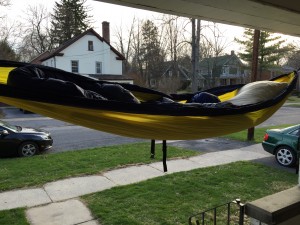By Paul Lallement
As the spring season is quickly approaching, the camping season is approaching as well. From there, a question comes to mind. How should I sleep outside? If you are a millennial like myself, then you grew up in the era of lightweight, free standing tents. Those are all well and good, but there is a way of building your nomadic home in the outdoors that is both lightweight and comfortable. I’m talking about hammocks, specifically hammocks made by Eagles Nest Outfitters (ENO). To give you a short synopsis of their history, they were first made by a couple of guys who were interested in improving the comfort of sleeping while on the road when seeing music and art festivals (think of things like Bonnaroo). They wanted to create something that was both functional and coincided with their laid-back lifestyle. These hammocks are made with parachute grade nylon and high strength paracord for a lightweight, yet strong system. I have used these hammocks on various camping expeditions and they are superior to traditional tents because they weigh less, and are more comfortable. Forget about finding a space on the ground that is free of roots or rocks that create uncomfortable spots on your body while sleeping. All you need are two average size trees for your anchors and you are ready for a good night’s sleep.
One of the beauties of traditional, lightweight, free-standing tents is that they come with a rain fly that fits snug over the tent itself. There are hammocks on the market that come with their own built in rain fly, but you can get by using your lightweight ENO hammock. ENO makes a rain fly that you can tie to surrounding trees to protect yourself from the rain. Another problem that comes with ENO hammocks is warmth. Since the hammock material is made from strong nylon, it is very air permeable. The wind can literally sweep the warmth right out from under you. To combat this, I recommend using a sleeping pad such as the RidgeRest or Z-lite from Therm-a-Rest. These help to create insulation between your body and the hammock. As far as sleeping bags go, most likely you will be using the hammock during the spring, summer, and fall seasons, so a super warm sleeping bag might not be the best choice. Instead, get something in the middle of the road with mesh ventilation at the feet. That way you can make a small cut in the mesh at the feet so the hammocks paracord can run through it. This makes the sleeping bag wrap completely around you and the hammock. But another question comes to mind with this system: why don’t you just use the sleeping bag normally with the hammock? Well, if you are in the sleeping bag while in the hammock, the bottom of the sleeping bag is sandwiched between you and the hammock, thus compressing it to the point where its insulating power does not work.
Hopefully these techniques can help you make the most out of your ENO Hammock experience. After all, anyone can use a hammock. Simply follow the instructions for set up, and you’re good to go. The next step is to get out there!

